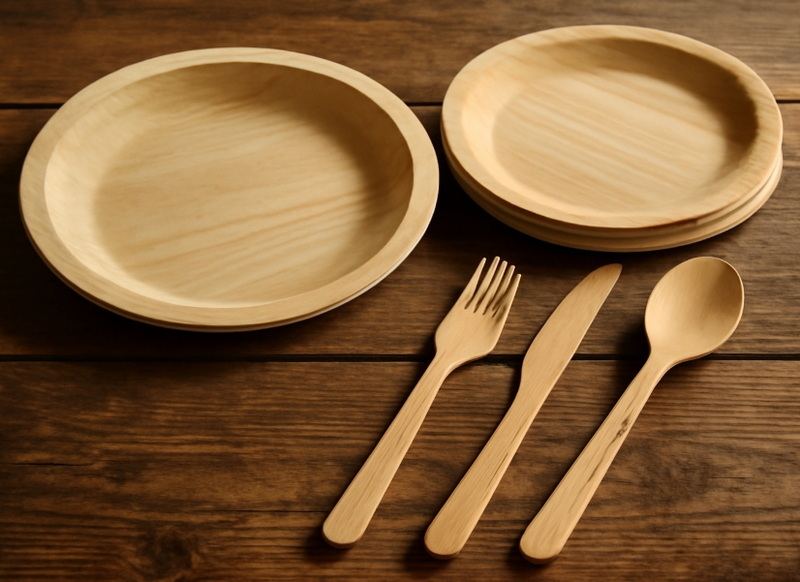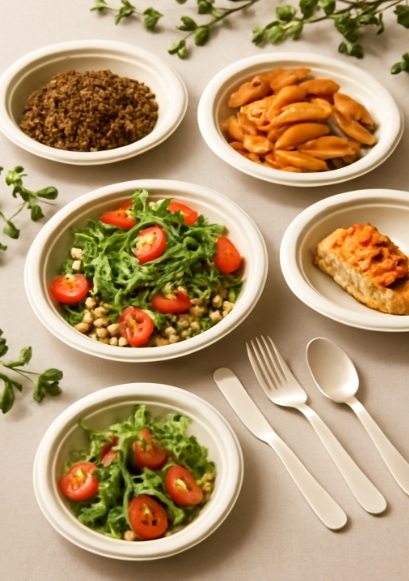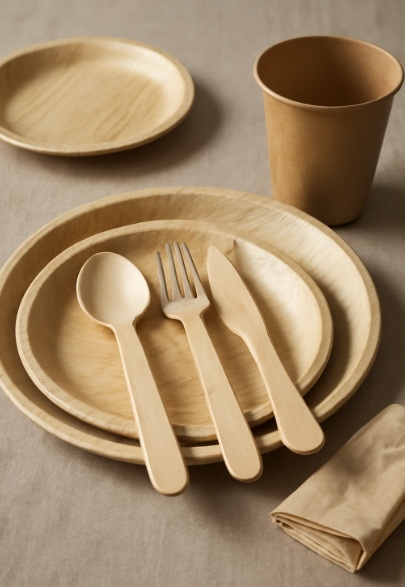
Content Menu
● What Makes Disposable Plates and Cutlery Eco-Friendly?
● Materials Used in Eco-Friendly Disposable Plates and Cutlery
>> Bamboo
>> Sugarcane Bagasse
>> Palm Leaves
>> Cornstarch and Wheat Straw
● Durability: How Do Eco-Friendly Plates and Cutlery Perform at Events?
>> Strength and Sturdiness
>> Heat and Moisture Resistance
>> Versatility and Usability
>> Convenience and Cleanup
● Environmental Benefits Beyond Durability
● Comparing Eco-Friendly and Traditional Disposable Tableware
● Addressing Common Concerns About Durability
>> Will Eco-Friendly Plates and Cutlery Break or Sog Easily?
>> Are They Suitable for All Types of Events?
>> Can They Be Used With Hot Foods and Liquids?
>> Are There Any Drawbacks?
● Practical Tips for Choosing Eco-Friendly Disposable Plates and Cutlery
>> Match the Tableware to the Menu
>> Assess the Event Style
>> Ensure Composting Facilities Are Available
>> Buy in Bulk for Large Events
● The Future of Eco-Friendly Disposable Plates and Cutlery
● Conclusion
● FAQ
>> 1. Are environmentally friendly disposable plates and cutlery as strong as traditional plastic options?
>> 2. Can eco-friendly disposable plates and cutlery be used for both hot and cold foods?
>> 3. Do eco-friendly disposable plates and cutlery ever get soggy or fall apart?
>> 4. Are there any health risks associated with using environmentally friendly disposable plates and cutlery?
>> 5. How should I dispose of eco-friendly disposable plates and cutlery after an event?
Sustainability has become a core value for event organizers and guests, driving a surge in demand for environmentally friendly disposable plates and cutlery. These products promise to minimize environmental impact while offering the convenience of single-use tableware. However, many planners and hosts wonder: Are eco-friendly disposable plates and cutlery durable enough for the rigors of large gatherings, from casual picnics to formal banquets? This comprehensive article explores the materials, manufacturing, durability, performance, and overall value of environmentally friendly disposable plates and cutlery, helping you make smart choices for your next event.

What Makes Disposable Plates and Cutlery Eco-Friendly?
Environmentally friendly disposable plates and cutlery are crafted from renewable, biodegradable, or compostable materials. Common sources include bamboo, sugarcane bagasse, palm leaves, cornstarch, and wheat straw. Unlike traditional plastic or foam options, these materials are designed to break down naturally, leaving no harmful residues and minimizing landfill waste. Their use of plant-based resources also reduces dependence on fossil fuels and lowers the carbon footprint of production.
Materials Used in Eco-Friendly Disposable Plates and Cutlery
Bamboo
Bamboo is renowned for its rapid growth and strength, making it a popular choice for eco-friendly plates and cutlery. Its natural fibers are tough, heat-resistant, and moisture-resistant, making bamboo tableware suitable for both hot and cold foods. Bamboo plates and utensils often have a smooth finish and a natural look that enhances the dining experience.
Sugarcane Bagasse
Bagasse is the fibrous residue left after extracting juice from sugarcane. This byproduct is molded into sturdy plates and cutlery that can handle a variety of foods and break down quickly in composting environments. Bagasse products are lightweight yet strong, and they resist becoming soggy, even when used with moist or greasy foods.
Palm Leaves
Plates and cutlery made from fallen palm leaves are naturally robust and feature unique, attractive patterns. They are free from chemical coatings and can withstand high temperatures without warping or leaking. Palm leaf tableware is especially popular for upscale events because of its rustic elegance and impressive strength.
Cornstarch and Wheat Straw
Cornstarch and wheat straw are used to create lightweight, compostable utensils and plates that are heat-resistant and suitable for both dry and moist foods. These materials are molded into various shapes and sizes, providing a versatile range of options for different event types.
Durability: How Do Eco-Friendly Plates and Cutlery Perform at Events?
Strength and Sturdiness
A crucial quality for event tableware is the ability to hold up under the weight of various foods. Modern environmentally friendly disposable plates and cutlery are engineered to be sturdy and reliable. Products made from bamboo, palm leaves, or sugarcane bagasse are particularly strong, capable of supporting heavy or saucy dishes without bending, breaking, or leaking. Unlike flimsy plastic or coated paper plates, these eco-friendly options maintain their integrity throughout the meal.
Heat and Moisture Resistance
Events often serve a range of hot and cold dishes, requiring tableware that can handle temperature extremes. Eco-friendly plates and cutlery made from bamboo, palm leaves, or bagasse are naturally heat-resistant and can safely be used with hot foods and liquids. These materials do not warp or release harmful chemicals when exposed to heat, unlike some plastics. Additionally, they resist moisture, preventing sogginess or disintegration when serving wet or greasy foods.
Versatility and Usability
Environmentally friendly disposable plates and cutlery are available in various shapes, sizes, and designs to suit different event styles, from casual picnics to elegant weddings. Their natural appearance adds a touch of sophistication, and many options are strong enough to be used with metal knives or for cutting tougher foods like steak.
Convenience and Cleanup
One of the main advantages of disposable tableware is the ease of cleanup. Eco-friendly plates and cutlery can be composted after use, eliminating the need for washing and reducing post-event waste. This convenience is especially valuable for large gatherings, where traditional dishwashing would be impractical.

Environmental Benefits Beyond Durability
While durability is key, the primary appeal of environmentally friendly disposable plates and cutlery lies in their sustainability:
- Biodegradability and Compostability: These products break down naturally within months, enriching the soil rather than polluting landfills.
- Reduced Pollution: By avoiding plastics and harmful chemicals, eco-friendly tableware prevents microplastic contamination and toxic leaching into food and the environment.
- Resource Conservation: Using renewable materials like bamboo and sugarcane reduces reliance on finite fossil fuels and supports sustainable agriculture.
- Lower Carbon Footprint: Manufacturing eco-friendly plates and cutlery typically consumes less energy and emits fewer greenhouse gases compared to traditional plastics.
Comparing Eco-Friendly and Traditional Disposable Tableware
| Feature | Eco-Friendly Plates & Cutlery | Traditional Plastic/Foam Plates & Cutlery |
| Material | Bamboo, bagasse, palm, etc. | Polystyrene, styrofoam, coated paper |
| Durability | High (for most options) | Varies; some are flimsy |
| Heat Resistance | Excellent | Often poor; may melt or leach chemicals |
| Compostable/Biodegrade | Yes (within months) | No (hundreds of years to decompose) |
| Environmental Impact | Minimal | High pollution, microplastics |
| Health Concerns | None (no toxic chemicals) | Possible chemical leaching |
| Aesthetic Appeal | Natural, elegant | Generic, less attractive |
Addressing Common Concerns About Durability
Will Eco-Friendly Plates and Cutlery Break or Sog Easily?
Modern manufacturing techniques have greatly improved the strength and stability of environmentally friendly disposable plates and cutlery. Bamboo and palm leaf products, in particular, are comparable to wood in sturdiness and can handle even heavy or wet foods without bending or breaking. Bagasse plates are similarly robust and resist becoming soggy, even with hot or greasy dishes.
Are They Suitable for All Types of Events?
Yes, environmentally friendly disposable plates and cutlery are suitable for a wide range of events, from outdoor barbecues to formal banquets. Their durability, heat resistance, and attractive appearance make them a versatile choice for any occasion.
Can They Be Used With Hot Foods and Liquids?
Most eco-friendly plates and cutlery are designed to withstand high temperatures and can be safely used with hot foods and beverages. They do not release harmful substances when heated, making them a safer alternative to many plastics.
Are There Any Drawbacks?
While eco-friendly plates and cutlery are highly durable for single-use purposes, they are not intended for repeated use. Some lightweight options made from cornstarch or wheat straw may be less sturdy than bamboo or palm leaf varieties, so it's important to choose the right product for your event's needs.
Practical Tips for Choosing Eco-Friendly Disposable Plates and Cutlery
Match the Tableware to the Menu
Consider the types of foods you plan to serve. For heavy, saucy, or hot dishes, opt for bamboo, bagasse, or palm leaf plates and cutlery, as they offer superior strength and heat resistance. For lighter fare, such as salads or desserts, cornstarch or wheat straw options may suffice.
Assess the Event Style
For formal events, choose plates and cutlery with elegant designs or natural finishes, such as palm leaf or bamboo, to enhance the table setting. For casual gatherings, simple bagasse or wheat straw products are practical and cost-effective.
Ensure Composting Facilities Are Available
To maximize the environmental benefits of your eco-friendly disposable plates and cutlery, ensure that composting facilities are accessible. If not, rest assured that these products will still break down much faster than traditional plastics in a landfill.
Buy in Bulk for Large Events
Purchasing environmentally friendly disposable plates and cutlery in bulk can help reduce costs and ensure you have enough tableware for all guests. Many suppliers offer event-sized packages with a variety of plate sizes and utensil types.
The Future of Eco-Friendly Disposable Plates and Cutlery
As technology advances, manufacturers continue to develop even more robust and sustainable options for disposable tableware. Innovations in material science are producing plates and cutlery that are not only stronger and more heat-resistant but also even faster to biodegrade. The growing popularity of these products is encouraging more venues and caterers to offer composting services, making it easier than ever to host a truly sustainable event.
Conclusion
Environmentally friendly disposable plates and cutlery have evolved into reliable, durable, and attractive options for events of all sizes. Made from renewable resources like bamboo, sugarcane bagasse, and palm leaves, these products combine strength, heat resistance, and sustainability. They hold up well to a variety of foods, resist sogginess, and make cleanup effortless. By choosing eco-friendly disposable plates and cutlery, you not only enhance the dining experience at your event but also contribute to a healthier planet by reducing waste, pollution, and resource consumption.

FAQ
1. Are environmentally friendly disposable plates and cutlery as strong as traditional plastic options?
Yes, many eco-friendly options-especially those made from bamboo, palm leaves, or sugarcane bagasse-are just as strong, if not stronger, than traditional plastic plates and cutlery. They can handle heavy, hot, or saucy foods without bending or breaking.
2. Can eco-friendly disposable plates and cutlery be used for both hot and cold foods?
Absolutely. Most environmentally friendly disposable plates and cutlery are heat-resistant and suitable for serving both hot and cold foods, making them versatile for any event.
3. Do eco-friendly disposable plates and cutlery ever get soggy or fall apart?
High-quality eco-friendly plates and cutlery are designed to resist moisture and maintain their structure throughout the meal. Products made from bamboo, palm leaves, or bagasse are particularly resistant to sogginess.
4. Are there any health risks associated with using environmentally friendly disposable plates and cutlery?
No. These products are typically free from harmful chemicals like BPA or phthalates, which are sometimes found in plastics. They are safe for food contact and do not leach toxins.
5. How should I dispose of eco-friendly disposable plates and cutlery after an event?
Most environmentally friendly disposable plates and cutlery are compostable. If you have access to a composting facility, dispose of them there. Otherwise, they will still break down much faster in a landfill than traditional plastics, minimizing environmental impact.

















